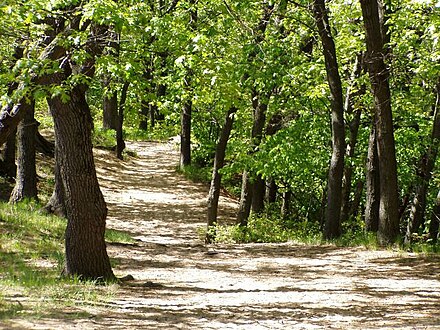Indiana Dunes National Park - United States National Park in Indiana
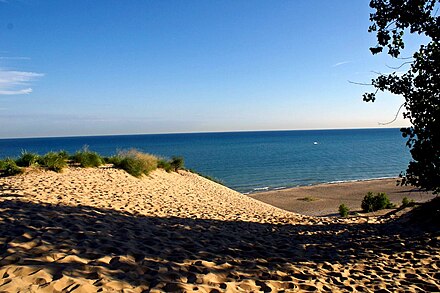
Indiana Dunes National Park is a United States national park located in Northwestern Indiana. The only national park in Indiana, it's popular for its big sand dunes and plentiful beaches on Lake Michigan, and for its easily accessible location near Chicago. The park is also home to a variety of ecosystems including swamps and forests, with diverse plants and wildlife.
Understand
History
The history of Indiana Dunes National Park falls into settlement, preservation, and park segments.
Settlement
Joseph and Monee Bailly, the fur traders, settled on the banks of the Little Calumet River in 1822. The wetlands of the Indiana Dunes proved to be a good place for contacts between the Bailly family and the Pottawatomie tribe of Native Americans. In 1822, the Pottawatomie nation had already developed an established lifestyle of duneland use, including the trapping of local beaver, raccoon, and muskrat.
After the Pottawatomie people were forcibly expelled from the Lake Michigan shoreline in the 1830s and 1840s, railroads built lines through the Indiana Dunes westward to the fast-growing city of Chicago; but the Dunes themselves, with their comparatively infertile soil, were settled relatively slowly.
Preservation
After the newly formed U.S. Steel Corporation began to construct a massive mill complex within the dunes at Gary, Indiana, lovers of the Dunes began efforts to preserve them. The National Park Service offered in 1916 to protect much of the remaining duneland as Sand Dunes National Park, but many locals opposed the proposal. In the 1920s, the state of Indiana preserved 2,182 acres of central duneland as Indiana Dunes State Park. Other sections of duneland were developed as the small communities of Ogden Dunes, Dune Acres, and Beverly Shores.
World War II and the early Cold War years increased pressure upon the United States to increase its production of steel. For reasons of economical coal and iron ore supply, one of the most efficient geographic locations to make steel within the United States is on the southern border of Lake Michigan. During the 1950s and early 1960s, several additional steel mills were sited within the dunelands in areas that could otherwise have been preserved for parkland.
After the former Bethlehem Steel Corporation acquired and built its Burns Harbor mill in 1962-64, a public outcry and pressure from activists, led by Sen. Paul H. Douglas (D-Ill.) led to the creation of the Indiana Dunes National Lakeshore, now the Indiana Dunes National Park.
National lakeshore and park
 The Indiana Dunes National Lakeshore was created by Congress in 1966. But it owned no land of its own, and land acquisition opportunities were limited because of previous development. Many local residents were understandably opposed to federal condemnation. By the 1980s, much of the 15,000 acres of land making up the current National Park (as of 2006) had been acquired. The federal government included the Indiana Dunes State Park within the boundaries of the national lakeshore, but has allowed the state to continue to maintain and charge a separate admission fee to the state park.
The Indiana Dunes National Lakeshore was created by Congress in 1966. But it owned no land of its own, and land acquisition opportunities were limited because of previous development. Many local residents were understandably opposed to federal condemnation. By the 1980s, much of the 15,000 acres of land making up the current National Park (as of 2006) had been acquired. The federal government included the Indiana Dunes State Park within the boundaries of the national lakeshore, but has allowed the state to continue to maintain and charge a separate admission fee to the state park.
By 2006, the lakeshore had come to include eight separate parcels of Lake Michigan beachfront land, as well as numerous parcels of property inland from the lake. Because the national park was founded after much of the drier land had already been developed, many of the inland parcels that make up the current park are riverbottoms or sandy wetlands.
In 2019, the National Lakeshore was reclassified and renamed a National Park, the first national park in Indiana.
Landscape
The Indiana Dunes, of which the Indiana Dunes National Park preserves a part, are a relatively recent product of sand deposition, wave erosion, and wind erosion on the southern tip of Lake Michigan. During the warming process that ended the last Ice Age, the lake at several periods rose to levels much higher than the current lake level and laid down sandy shorelines and beaches at points that are now inland from the current coastline. Today's lake waves and currents continue to bring more sand ashore from beds underneath the surface of the current lake. This sand, further sculpted by wind and foot erosion, has become today's Indiana Dunes.
Flora and fauna
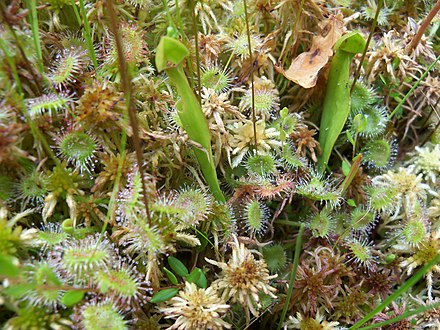 Many ecosystem types can be readily recognized by amateurs. Ecosystem types, and characteristic grasses and flowering plants, that exist within the Indiana Dunes include the following:
Many ecosystem types can be readily recognized by amateurs. Ecosystem types, and characteristic grasses and flowering plants, that exist within the Indiana Dunes include the following:
- Sand dunes - marram grass, prickly pear, puccoon
- Wetlands (bogs, marshlands, and swamps) - marsh marigold, skunk cabbage
- Ponds - bladderwort, gentian
- Prairies - black-eyed susan, butterfly weed, goldenrod, lupine, prairie grass
- Savannas - asters, prairie grass
- Dry woods - columbines, hepatica, Solomon's seal
- Wet woods - Dutchmen's breeches, hepatica, trillium, violet
The most common large tree in the Indiana Dunes is the black oak. There are also plenty of cottonwoods. Jack pines often grow in burned-over or disturbed areas, and there are several groves of sugar maples (the Bailly/Chellberg farm operates an maple-syrup boil in early spring). A grove of paper birches on the Cowles Bog Trail is said to be the farthest-south naturally reproducing population of this species in the Great Lakes area.
As of January 2006, whitetail deer lived in quantity in the Indiana Dunes. The common North American wetland and woodland rodents, such as beavers, muskrats, and squirrels, can be easily seen.
Climate
The Indiana Dunes are part of the temperate Great Lakes shoreline, characterized by relatively even amounts of rain and snow year-round, but wide jumps in temperature. A dunes shoreline that is crowded with swimmers in August may be caked with unsafe but majestic shelves of pack ice in February.
Visitor information centers
- Indiana Dunes Visitor Center (Dorothy Buell Visitor Center), 1215 North State Road 49, Porter, 41.6332°, -87.0543°. 8AM-6PM (Summer, Friday of Memorial Day weekend through Monday of Labor Day weekend). 8:30AM-4:30PM (Winter). View lobby displays and pick up brochures about Porter County, Indiana, Dunes State Park, and Indiana Dunes National Park. Enjoy educational displays and watch two short orientation videos. Shop in the Eastern National bookstore. The visitor center is open everyday with the exception of Thanksgiving Day, Christmas Day, and New Year's Day. 2020-06-28
- Paul H. Douglas Center for Environmental Education, 100 North Lake Street, Gary, 41.6063°, -87.2675°. 9AM-5PM (Summer, Friday of Memorial Day weekend through the Monday of Labor Day weekend). 9AM-4PM (Winter). Visitor activities include attending scheduled programs for groups presented by the national lakeshore or hiking the Miller Woods Trail. The Paul H. Douglas Center is open everyday with the exception of federal holidays. 2020-06-28
Get in
By car
The Indiana Dunes area is accessible from Chicago by Interstates 80, 90, and 94; from Indianapolis by Interstate 65; from Detroit by Interstate 94; and from Cleveland and the East Coast by Interstates 80 and 90. U.S. Highways 12 and 20 go directly through the park.
By train
The Indiana Dunes are served by the South Shore Line from Chicago, Michigan City, and South Bend. There are approximately 12 trains through the Park each way on weekends, with 9 trains each way on Saturdays, Sundays, and holidays. As of May 2021, the train service has been replaced by buses between Gary and South Bend due to track construction. The project is scheduled to end in May, but conductors think it could last for most of summer 2021. There are several stations near the dunes:
- Dune Park is closest to the Indiana Dunes State Park. Follow the signs out of the station and walk along a sidewalk about 20 min to the park's main entrance.
- Portage/Ogden Dunes is closest to Ogden Dunes. To get to the West Beach Recreation Area, walk North through the town to the intersection of Diana Road and Ski Hill Road (about 20 min) and enter Long Lake Park. Follow the path past the tennis courts and along the lake; at the very end it connects to the West Beach Trail in the recreation area.
You can take bikes on the South Shore Line, but they are only permitted on some trains and some stations. As of May 2021, the only station near the dunes that accepts bikes was Dune Park, but even that was not allowed due to construction.
Fees and permits
Most inland sections of the Indiana Dunes National Park can be visited year-round without an admission fee. Parking fees may be charged during seasonal festivals. Entrances fees are charged for accessing the park's West Beach area; as of 2020 this fee was $6 per vehicle. As of January 1, 2006, the admission fee for entering the Indiana Dunes State Park section of the National Lakeshore was $10.00 per motor vehicle. The fee covers the driver and passengers, and there is a discount for motor vehicles with Indiana license plates.
Get around
By bike
Most of the hiking trails are closed to bikes, but the Calumet Trail runs parallel to Dunes Highway and can be used to transit between some parts of the park.
See
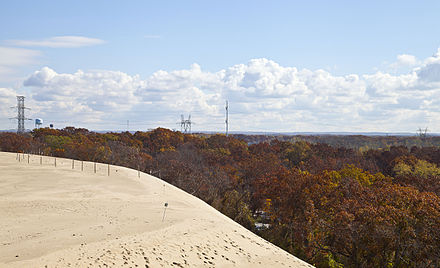
-
Lake Michigan. Accessible via a short walk from any of the beach access parking areas. For visitors, who have limited mobility can view the lake from Lakefront Drive through Beverly shores or from the Dunbar Ave. Parking lot. Drive out to Portage Lakefront and Riverwalk. Here, you have a spectacular view to the north across Lake Michigan. On clear days or days when clouds hang over the water, you can see the skyline of Chicago off to the northwest.
-
Mt. Baldy. While hiking to the top is a challenge, as worth the time, you can see the moving southface from the Mt. Baldy parking lot. In a windy year, it will move another foot towards the lot.
-
Inland Marsh Overlook. A unique attraction is the marsh overlook. An unimposing parking area and a picnic table are the only clue that this short trail exist. It's all boardwalk and easily accessible by wheelchair or walker. You'll walk a short distance across a bridge between two tree covered dunes. From ground level to the tree tops and there are no steps. Once to the overlook, you'll see a vast inland marsh. During migration, the area can host flocks of arctic wanderers and other summer residents from the tropics.
-
Century of Progress Homes, 41.68427°, -87.00207°. See five buildings, all from the Homes of Tomorrow Exhibition of the 1933 Century of Progress World's Fair which took place in Chicago. They were originally intended to display the future of housing, and today are private residences with nearby plaques. 2021-05-16
Nearby attractions
- The Depot of Beverly Shores - South Shore Line Passenger Depot,
- Museum and Art Gallery - 525 Broadway, Beverly Shores (on U.S. 12)
Do
Swimming
The beaches, owing to the deep blue, often clear water, as well as the huge dunes and the copious sand they bring, are beautiful. Industrial vistas in the distance can lessen the bucolic impact, although with a good sense of humor and appreciation for the weird, they can add to the experience. The worst industrial offender is the big power plant to the east of the park, which is very visible from both Central Beach and the beach below Mt Baldy. A generally useful tip is that the beaches are more crowded with proximity to Chicago. The least crowded, on average, are the two at the east (Central and Mt Baldy). Going to the beach at the state park is also a good way to get more beach space since Indiana charges an entrance fee. Now of course, if you're from a more crowded section of the country on the East Coast or California, you'll feel like you have an extraordinary amount of space no matter which beach you choose.
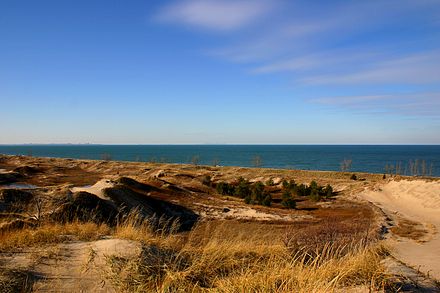 From East to West:
From East to West:
- West Beach. The sole beach west of the Port of Indiana and its steel mills. It's right by Long Lake, and several nice, short trails through the woods. As it is the park's largest and most visited, it also has the most amenities.
- Porter Beach. Just west of the state park section of the shoreline.
- Kemil and Dunbar Beaches. Less than a half mile apart, Kemil is wheelchair-accessible.
- Lake View. Along with Kemil and Dunbar Beaches, Lake View is one of the most isolated from industrial vistas.
- Central Beach. As it is far enough east, Central Beach is one of the frequently visited beaches, despite being not very easy to reach—nonetheless Mt Baldy probably has claim the title of most remote.
Picnic
There are numerous picnic areas for those who wish to make a day of it. Picnicking on the beaches is allowed. No glass containers are allowed on the beach. Nearby some of the beaches you'll find picnic tables, including a large family or group picnic area at West Beach and family tables at Mt. Baldy. From the west, picnic areas include: West Beach, Bailly Homestead-Chellberg Faram, Tremont (roadside rest on U.S. 12), Ly-co-ki-we Horse and Hiking trailhead (U.S. 20), Lake View beach access point(Lakefront Dr, Beverly Shores), Central Beach Access Point, and Mt. Baldy. Fires are not permitted on any of the beaches. That includes grilling on the beaches and any beach to the East of State Park Road.
Hiking
The park has several miles of dedicated hiking trails. On the dunes themselves, the trail surface can be soft sand, which is just as challenging to walk on as a sandy beach. Don't forget to empty the sand out of your shoes before you go home!
- Trail 9 in the Indiana Dunes State Park. Hike over some dunes for spectacular views of Lake Michigan and--on a clear day--the Chicago Skyline
- 3 Dunes Challenge. Challenge your calves and climb three separate dunes in the Indiana Dunes State Park: Mount Tom, Mount Holden, and Mont Jackson. Stop by the visitor center to get your completion prize.
- Mt Baldy, 41.7089°, -86.9281°. The name of the park's highest dune, and given the height of the dunes around the beach, this beach is the most strenuous to reach. The views from the top of the "mountain" are quite nice, and reward the heavy breathing you'll do on the trail to the top. Don't let the fear-mongering signage dissuade you, though, the trek really is not too hard, as it is a gentle incline heading up. Walking in sand even on a slight incline, though, is a good deal harder than on solid ground. The drop from Mt Baldy to the beach is extreme, and goofing around on the steep slope is a bad idea—sand is soft, but you could pick up enough speed rolling down to seriously injure yourself. There is an alternate path further back along the Mount Baldy trail that will take you to the beach without the sharp incline. Mount Baldy is suffering from increasing erosion, in part due to off-trail hiking. Please only hike the main trail on Mount Baldy.
Bird watching
At the southern tip of Lake Michigan, the Indiana Dunes is a natural way-station on the annual migration of birds. Over 300 species birds live or pass through the park. The greatest concentrations are during the spring (April–May) and autumn (September–October) migrations.
Biking
The Calumet Trail, a multi-use, crushed-limestone trail where cycling is acceptable, also runs in a generally east-west direction through the eastern section of the park, providing access to the Indiana Dunes State Park and towns to the east. It skirts a wooded area where deer and other wildlife may often be seen, especially early in the morning. It also follows the path of several large power lines.
Horseback riding
Horseback riding is limited to the Ly-co-ki-we Horse and Hiking trail, off U.S. 20 at Schoolhouse Road. There are no stables provided in the park. Riders have to bring their own horses. On sunny Saturdays, this is a great area to watch a variety of horses. No dogs or any other animals are allowed, other than horses.
Fishing & boating

Skiing
In the winter, cross-country skiing is possible. The park is beautiful under the snow.
Buy
Eat
There are no services in the park, but the park has numerous communities adjacent to its boundaries. Concentrations of restaurants, including fast-food and family restaurants are at the major freeway interchanges:
- I-94 and Hwy. 51-Gary/Miller/Lake Station
- I-94 and Hwy. 249-Portage
- I-94 and Hwy. 20-Burns Harbor/Porter
- I-94 and Hwy. 49-Porter/Chesterton, and,
- I-94 and Hwy. 421-Michigan City.
If you're willing to browse around, you can find many smaller local restaurants in the communities nearby.
Drink
Alcohol is allowed everywhere in the national park, except inside NPS buildings. No glass is allowed on the beach.
Sleep
Lodging
There are no lodging options within the state or national parks aside from camping, but the nearby towns of Chesterton and Porter have several options.
Camping
- Dunewood Campground, 41.6720°, -86.9838°. 66 sites. All sites are first-come, first-served. The campground is fairly open with few trees between sites. There are two large modern bathhouses with showers and several pit-toilets scattered around. The dunes area is all sand and the campground is no exception. Grass is sparse in some areas and expect to get sand in everything. The campground is often full by the Friday before most summer weekends so it pays to arrive early to secure a site. Consists of two loops containing 66 camp-sites (53 conventional drive-in sites and 13 walk/carry-in sites). Four sites are wheelchair accessible (numbers 15, 30, 41 and 55). Each loop has modern restrooms and hot/cold showers. Some sites have limited recreational vehicle length. Convenience stores and a gas station are located 1/4 mile north of the campground at the intersection of U.S. Highway 12 and Broadway Avenue in the town of Beverly Shores. $25 Dunewood Campground Fee (2020 rates) 2020-06-28
- Indiana Dunes State Park, 41.66°, -87.04°. 2021-05-16
Backcountry
The National Park has no wilderness area nor backcountry. Overnight stays are permitted only in Dunewood Campground, the State Park's campground or local motels which may be along the boundary of the park. All of the beach access parking lots are closed at dusk as there is no overnight use of the beaches.
Stay safe
Lake Michigan can have strong riptides and there are no lifeguards on several sections of the beach. Look for the warning signs at beach entrances. Sometimes they advise not entering the water at all. During the winter pack ice forms in thick chunks but is dangerous to walk on.
The area's only venomous snake, the massasauga rattlesnake, is occasionally seen in the forested parts of the park away from the beaches and dunes. However, it is not aggressive if left alone, hardly the most potent of rattlers, and the chances of running into one are nil.
Go next
Related: United States National Parks
Indiana Dunes National Park
nps.gov/indu/index.htmPorter County
2nd-order administrative division
Indiana
Primary administrative division
United States
usa.govPopulation:327.2 MDial code:+1Currency:Dollar (USD)Voltage:120 V, 240 V, 60 HzNEMA 14-30NEMA 14-50
